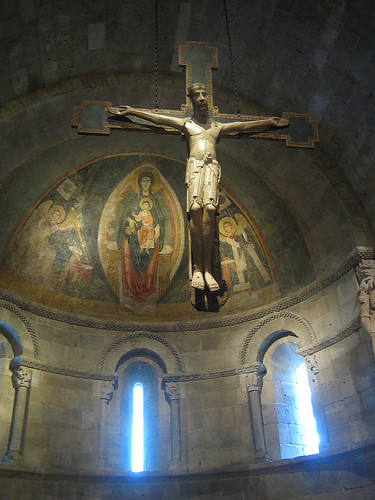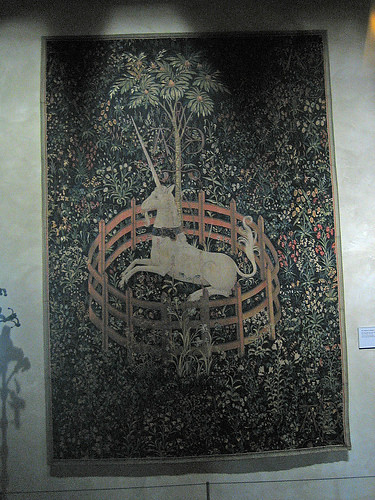In 2010, I visited it for the first time and blogged about it rather broadly. Today, I set up another task of choosing two artworks collected there touched me the most. My picks are a wood sculpture of Crucifix and a tapestry featuring a unicorn in captivity.
The below Crucifix was as moving and otherworldly as a religious devotional piece can be. Its seemingly stiff and old fashioned curving actually enhanced its mystery to modern eyes. It was a reminder of the ancientness of Christian cult and the surrounding murals of Mother of God and other Saints complemented this powerful work wonderfully with their multiple-hued coloration and softer lines. Below the sculpture, narrow slits of lights illuminated the vault reluctantly, and added extra layer of drama and mystery.

Crucifix, Palencia, Castile-León, Spain, c. 1150–1200
Corpus: white oak and pine with polychromy, gilding, and applied stones; Cross: red pine, polychromy
The other favorite of my there is "The Unicorn in Captivity". Crucifix is a religious artifact, while this one is fantastical one, rooted in our ancestors' uninhabited imagination. It mingled, rather deftly, the secular and spiritual. It also embodies the medieval people's desire for a world which was pure and bountiful. Alas, that paradise didn't exist.

The Unicorn in Captive, South Netherlandish, c. 1495-1505
Wool warp with wool, silk, silver, and gilt wefts
The Cloisters web site stated that "The Unicorn in Captivity" may have been created as a single image rather than part of a series. In this instance, the unicorn probably represents the beloved tamed. He is tethered to a tree and constrained by a fence, but the chain is not secure and the fence is low enough to leap over: The unicorn could escape if he wished. Clearly, however, his confinement is a happy one, to which the ripe, seed-laden pomegranates in the tree—a medieval symbol of fertility and marriage—testify. The red stains on his flank do not appear to be blood, as there are no visible wounds like those in the hunting series; rather, they represent juice dripping from bursting pomegranates above. Many of the other plants represented here, such as wild orchid, bistort, and thistle, echo this theme of marriage and procreation: they were acclaimed in the Middle Ages as fertility aids for both men and women. Even the little frog, nestled among the violets at the lower right, was cited by medieval writers for its noisy mating."
My Favorite Museum Collection Series
>> My Favorite Museum Collection Series 7: An Exception - Another Favorite Work from De Young Museum, San Francisco
<< My Favorite Museum Collection Series 5: My Favorite Paintings at Metropolitan Museum, New York





No comments:
Post a Comment